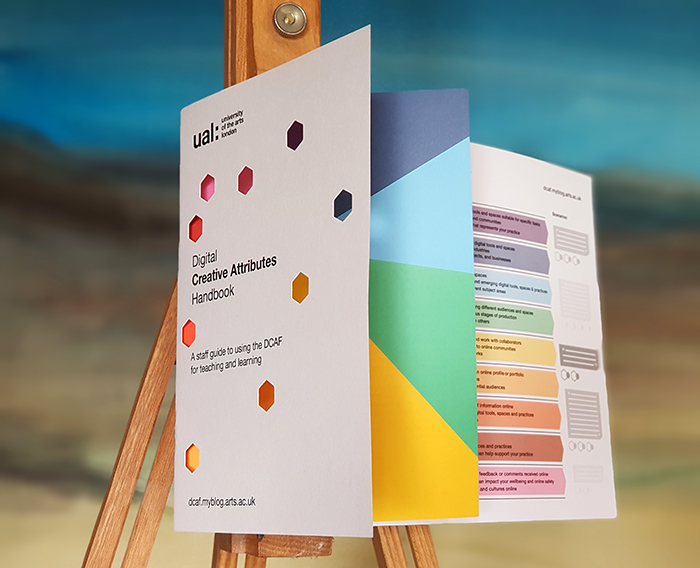[The framework, handbook and associated guidance can be found here: http://dcaf.myblog.arts.ac.uk – a PDF of the core framework can be downloaded here]
One weakness of a ‘graduate attributes’ approach for student development is that it looks lovely in strategy documents but can be difficult to respond to on a day-to-day basis, especially in digital contexts. For example, a graduate attribute that talks about students becoming ‘agile connectors’ sounds positive but how does a course leader respond to that when designing curriculum? They might have a sense of what agile connecting looks like in their discipline but add digital to the mix and it suddenly they are casting about for the latest app or platform as a placeholder for teaching practice. Unfortunately, this fuels a demand for a more ‘skills focused’ approach in which a list of this week’s popular technologies is drawn up with advice on what it can be ‘used for’. With the best will in the world this approach always puts the tech before the teaching and course leaders feel a pressure to ‘introduce technology’ to ‘keep up’.
So, we often end up with the macro of ‘attributes’ and the micro of the tech-list. What is missing is a ‘meso’, or middle level, connecting the two. Connecting high-level aspirations through to practical activity is the principle behind the Digital Creative Attributes we have developed at the University of the Arts London. These are an extension of the Creative Attributes Framework at the UAL which lays out nine key attribute areas in three groups. The Digital Creative Attributes Framework (rather pleasingly the ‘D-CAF’) is a digital expression on the CAF, not a whole new framework. It provides a meso layer of digital practices for courses to build on or map to.
There are four significant advantages to this approach:
- DCAF practices are stable. Digital platforms, apps and software might change but the practices we require to thrive in the digital environment remain the same.
- DCAF is not discipline specific so each group can contextualise relevant practices in a manner which makes sense for them.
- DCAF can be used to articulate current curriculum in digital-practice terms. It’s not a list of ‘things you haven’t managed to include’ but a framework which can highlight to students the value of engaging in the curriculum in certain ways.
- DCAF provides a shared language which works for staff, students and the creative industries.
The last point was extremely important to me because I’ve been in too many meetings where the lack of a shared language around digital has seriously disrupted meaningful progress. Essentially, when we say the word ‘digital’ in an institutional context everyone thinks of different things and wants to set different priorities. The tech folk call for more kit, senior folk want a clear ‘vision’ and everyone else just wants some support and guidance. Saying ‘let’s talk about digital’ is the same as saying ‘let’s talk about the university’ both these topics are far too big and neither of them can be ‘solved’.
The DCAF is designed to focus these discussions around a set of practices we know the students want/need to develop. It respects the importance of disciplinary context and avoids the techno-solutionist trap.
We have released the DCAF under a Creative Commons licence to open it out to all. It gives a good insight into the digital practices which underpin creative working and as such is relevant to anyone taking a creative approach to teaching and learning.

2 thoughts on “Digital Creative Attributes Framework”